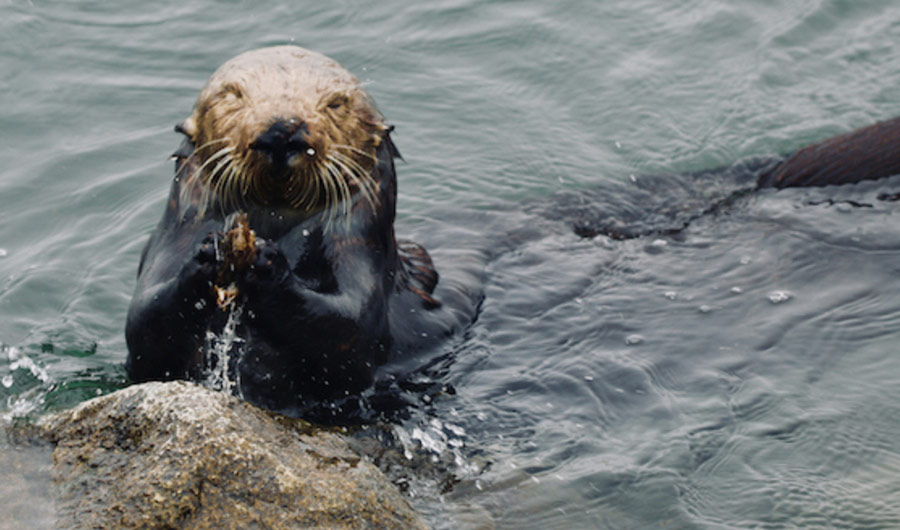Researchers Discover that Sea Otters Leave Behind Archaeological Records

Sea otter pounding open mussels at Bennett Slough Culverts in upright position.
Jessica Fujii
This image may only be reproduced with this Inside Science article.
(Inside Science) -- No one has ever confused sea otters with humans. They are furry, aquatic mustelids -- the taxonomic family that includes such carnivorous mammals as weasels, ferrets, badgers and similar animals. And humans, of course, are upright-walking, language-creating primates. Yet, the two creatures share at least one similarity: They both manipulate and use tools.
Now researchers report that otter tool use -- specifically, using stones to crack open the hard shells of clams and other marine creatures -- can leave behind distinct evidence similar to what is found at human archeological sites.
“We’ve known for quite a long time that sea otters use tools,” said Jessica Fujii, a senior research biologist at the Monterey Bay Aquarium in California who took part in the new study.
On just about any day in central and northern California, sea otters can be seen along rocky shores or congregated in coastal estuaries engaged in their typical feeding behavior. After diving and foraging along the bottom, they pop up to the surface with a freshly scavenged mussel, abalone or clam. They float on their backs and use a stone as either an anvil or a hammer to crack open the shells.
But sea otters also use stationary rocks or rocky outcroppings along the shore to smash open their favorite foods.
In a paper published today in the journal Scientific Reports, Fujii and her colleagues present evidence that for at least 10 years sea otters have been using a particular rocky outcropping along the estuary shore at Elkhorn Slough near Moss Landing, California, to crack open mussels and get at the meaty, nutritious tissue inside.
“We discovered that sea otters were pounding mussels on these rocks along the shoreline, and by examining the rocks we found that they were leaving these very distinct traces of damage on the rocks,” Fujii said.
The researchers found white “scuff” marks on the high and prominent ridges, or points, of the outcropping, while similar scuff marks do not appear on the flat areas, indicating that the otters are clearly targeting these high and prominent points.
The pattern of breakage on the shells, moreover, is equally distinctive. Most commonly, Fujii and her team observed otters holding the shells in their forepaws and striking downward against the rock. The shells were repeatedly hammered -- up to 30 times -- against a high point or ridge. Once a shell was sufficiently weakened, the otter opened the shell with its teeth and feasted on the contents. This downward motion left a particular breakage pattern almost invariably characterized by one side of the shell left intact, which the researchers designated the “left side.” The hinge was also left intact. However, the opposite side, or “right side,” of the shell was fractured or completely broken off. This fragmented side of the shell, which received the full brunt of the pounding, also exhibited a distinctive diagonal fracture scar.
Fujii and her colleagues believe this pattern may result from “pawedness” – or a preference for the right paw over the left. The researchers observed the otters initially holding the mussels symmetrically with one paw on each side of the shell. But during the downward stroke, the otters turned their wrists slightly so that the right side of the shell was angled toward the rock.
The process scatters most of the shell debris about the rocks. Based on their observations, the authors suggest that even a few otters engaged in this behavior can over time create a sizable accumulation of shells, or a “midden” at a particular spot that is used over and over again.
Together, the scuff marks on the rocks and the broken, scattered shells have created what the authors contend is an “archaeological site.” In this instance, however, the site is the product of foraging otters rather than humans.
By studying this distinct and deliberately created sea otter midden, the researchers believe they’ll be able to identify other similar middens throughout the world, and, importantly, help to document past sea otter presence in areas where the creatures are now extinct.
“This information could help archaeologists determine whether mussel shells were broken by otters or humans,” said Stella D’Oro, an archaeologist working in Santa Cruz, California.

